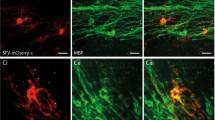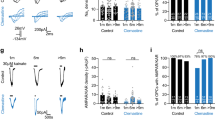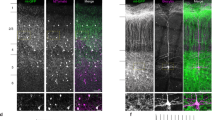Abstract
Central nervous system myelin is a specialized structure produced by oligodendrocytes that ensheaths axons, allowing rapid and efficient saltatory conduction of action potentials1. Many disorders promote damage to and eventual loss of the myelin sheath, which often results in significant neurological morbidity. However, little is known about the fundamental mechanisms that initiate myelin damage, with the assumption being that its fate follows that of the parent oligodendrocyte. Here we show that NMDA (N-methyl-d-aspartate) glutamate receptors mediate Ca2+ accumulation in central myelin in response to chemical ischaemia in vitro. Using two-photon microscopy, we imaged fluorescence of the Ca2+ indicator X-rhod-1 loaded into oligodendrocytes and the cytoplasmic compartment of the myelin sheath in adult rat optic nerves. The AMPA (α-amino-3-hydroxy-5-methyl-4-isoxazole propionic acid)/kainate receptor antagonist NBQX2 completely blocked the ischaemic Ca2+ increase in oligodendroglial cell bodies, but only modestly reduced the Ca2+ increase in myelin. In contrast, the Ca2+ increase in myelin was abolished by broad-spectrum NMDA receptor antagonists (MK-801, 7-chlorokynurenic acid, d-AP53,4), but not by more selective blockers of NR2A and NR2B subunit-containing receptors (NVP-AAM0775 and ifenprodil2,4). In vitro ischaemia causes ultrastructural damage to both axon cylinders and myelin6. NMDA receptor antagonism greatly reduced the damage to myelin. NR1, NR2 and NR3 subunits were detected in myelin by immunohistochemistry and immunoprecipitation, indicating that all necessary subunits are present for the formation of functional NMDA receptors. Our data show that the mature myelin sheath can respond independently to injurious stimuli. Given that axons are known to release glutamate7,8,9, our finding that the Ca2+ increase was mediated in large part by activation of myelinic NMDA receptors suggests a new mechanism of axo–myelinic signalling. Such a mechanism may represent a potentially important therapeutic target in disorders in which demyelination is a prominent feature, such as multiple sclerosis, neurotrauma, infections (for example, HIV encephalomyelopathy) and aspects of ischaemic brain injury.
This is a preview of subscription content, access via your institution
Access options
Subscribe to this journal
Receive 51 print issues and online access
$199.00 per year
only $3.90 per issue
Buy this article
- Purchase on Springer Link
- Instant access to full article PDF
Prices may be subject to local taxes which are calculated during checkout




Similar content being viewed by others
References
Waxman, S. G., Kocsis, J. D. & Stys, P. K. The Axon: Structure, Function and Pathophysiology (Oxford Univ. Press, Oxford, 1995)
Dingledine, R., Borges, K., Bowie, D. & Traynelis, S. F. The glutamate receptor ion channels. Pharmacol. Rev. 51, 7–61 (1999)
Waxman, E. A. & Lynch, D. R. N-methyl-d-aspartate receptor subtypes: multiple roles in excitotoxicity and neurological disease. Neuroscientist 11, 37–49 (2005)
Parsons, C. G., Danysh, W. & Quack, G. Glutamate in CNS disorders as a target for drug development: an update. Drug News Perspect. 11, 523–569 (1998)
Auberson, Y. P. et al. 5-phosphonomethylquinoxalinediones as competitive NMDA receptor antagonists with a preference for the human 1A/2A, rather than 1A/2B receptor composition. Bioorg. Med. Chem. Lett. 12, 1099–1102 (2002)
Waxman, S. G., Black, J. A., Stys, P. K. & Ransom, B. R. Ultrastructural concomitants of anoxic injury and early post-anoxic recovery in rat optic nerve. Brain Res. 574, 105–119 (1992)
Lin, S. C. et al. Climbing fiber innervation of NG2-expressing glia in the mammalian cerebellum. Neuron 46, 773–785 (2005)
Li, S., Mealing, G. A., Morley, P. & Stys, P. K. Novel injury mechanism in anoxia and trauma of spinal cord white matter: glutamate release via reverse Na+-dependent glutamate transport. J. Neurosci. 19, RC16 (1999)
Chiu, S. Y. & Kriegler, S. Neurotransmitter-mediated signalling between axons and glial cells. Glia 11, 191–200 (1994)
Matute, C., Alberdi, E., Ibarretxe, G. & Sanchez-Gomez, M. V. Excitotoxicity in glial cells. Eur. J. Pharmacol. 447, 239–246 (2002)
Ziak, D., Chvatal, A. & Sykova, E. Glutamate-, kainate- and NMDA-evoked membrane currents in identified glial cells in rat spinal cord slice. Physiol. Res. 47, 365–375 (1998)
Das, S. et al. Increased NMDA current and spine density in mice lacking the NMDA receptor subunit NR3A. Nature 393, 377–381 (1998)
McDonald, J. W., Althomsons, S. P., Hyrc, K. L., Choi, D. W. & Goldberg, M. P. Oligodendrocytes from forebrain are highly vulnerable to AMPA/kainate receptor-mediated excitotoxicity. Nature Med. 4, 291–297 (1998)
Rosenberg, P. A. et al. Mature myelin basic protein-expressing oligodendrocytes are insensitive to kainate toxicity. J. Neurosci. Res. 71, 237–245 (2003)
Lazzarini, R. A. et al. Myelin Biology and Disorders (Elsevier, Amsterdam, 2004)
Michailov, G. V. et al. Axonal neuregulin-1 regulates myelin sheath thickness. Science 304, 700–703 (2004)
Quarles, R. H., Macklin, W. B. & Morell, P. in Basic Neurochemistry (eds Siegel, G. J., Albers, R. W., Brady, S. T. & Price, D. L.) 51–72 (Elsevier, San Diego, in the press)
Mrsulja, B. J., Zalewski, A. A. & Coping, G. Ultracytochemical localization of ouabain-sensitive K+-dependent, p-nitrophenyl phosphatase in myelin. Brain Res. 343, 154–158 (1985)
Kamasawa, N. et al. Connexin-47 and connexin-32 in gap junctions of oligodendrocyte somata, myelin sheaths, paranodal loops and Schmidt-Lanterman incisures: implications for ionic homeostasis and potassium siphoning. Neuroscience 136, 65–86 (2005)
Brand-Schieber, E. & Werner, P. AMPA/kainate receptors in mouse spinal cord: cell-specific display of receptor subunits by oligodendrocytes and astrocytes and at the nodes of Ranvier. Glia 42, 12–24 (2003)
Li, S. & Stys, P. K. Mechanisms of ionotropic glutamate receptor-mediated excitotoxicity in isolated spinal cord white matter. J. Neurosci. 20, 1190–1198 (2000)
Hinman, J. D., Duce, J. A., Siman, R. A., Hollander, W. & Abraham, C. R. Activation of calpain-1 in myelin and microglia in the white matter of the aged rhesus monkey. J. Neurochem. 89, 430–441 (2004)
Mayer, M. L., Westbrook, G. L. & Guthrie, P. B. Voltage-dependent block by Mg2+ of NMDA responses in spinal cord neurones. Nature 309, 261–263 (1984)
Aragon, C. & Lopez-Corcuera, B. Structure, function and regulation of glycine neurotransporters. Eur. J. Pharmacol. 479, 249–262 (2003)
Danbolt, N. C. Glutamate uptake. Prog. Neurobiol. 65, 1–105 (2001)
Stys, P. K. White matter injury mechanisms. Curr. Mol. Med. 4, 113–130 (2004)
Spike, R. C., Watt, C., Zafra, F. & Todd, A. J. An ultrastructural study of the glycine transporter GLYT2 and its association with glycine in the superficial laminae of the rat spinal dorsal horn. Neuroscience 77, 543–551 (1997)
Bear, M. F. & Malenka, R. C. Synaptic plasticity: LTP and LTD. Curr. Opin. Neurobiol. 4, 389–399 (1994)
Lipton, S. A. & Rosenberg, P. A. Excitatory amino acids as a final common pathway for neurologic disorders. N. Engl. J. Med. 330, 613–622 (1994)
Wallstrom, E. et al. Memantine abrogates neurological deficits, but not CNS inflammation, in Lewis rat experimental autoimmune encephalomyelitis. J. Neurol. Sci. 137, 89–96 (1996)
Acknowledgements
This work was supported by the NINDS, CIHR, Heart and Stroke Foundation of Ontario Center for Stroke Recovery, an HSFO Career Investigator Award, the Canadian Institute for Photonic Innovations, and the generosity of private donors to P.K.S. G.W.Z. is a Canada Research Chair and an AHFMR Senior Scholar. This work was additionally supported by the CIHR (G.W.Z., J.E.M.) and NINDS (B.D.T.). We thank Y. Auberson for the gift of NVP-AAM077; J. A. Wang and C. E. Morris for providing HEK293 cells for fluorescence-lifetime measurements; and M. Nikolaeva for assistance with fluo-4 Ca2+ imaging.
Author information
Authors and Affiliations
Corresponding author
Ethics declarations
Competing interests
Reprints and permissions information is available at npg.nature.com/reprintsandpermissions. The authors declare no competing financial interests.
Supplementary information
Supplementary Notes
This file contains Supplementary Figures 1–3 and Supplementary Legends 1–3, Supplementary Methods, Supplementary Notes (statistics, abbreviations, author contributions, additional references pertaining to supplementary methods) and Supplementary Methods.
Rights and permissions
About this article
Cite this article
Micu, I., Jiang, Q., Coderre, E. et al. NMDA receptors mediate calcium accumulation in myelin during chemical ischaemia. Nature 439, 988–992 (2006). https://doi.org/10.1038/nature04474
Received:
Accepted:
Published:
Issue Date:
DOI: https://doi.org/10.1038/nature04474
This article is cited by
-
Therapeutic potential of N-methyl-D-aspartate receptor modulators in psychiatry
Neuropsychopharmacology (2024)
-
Oligodendrocyte–axon metabolic coupling is mediated by extracellular K+ and maintains axonal health
Nature Neuroscience (2024)
-
NMDAR1 autoantibodies amplify behavioral phenotypes of genetic white matter inflammation: a mild encephalitis model with neuropsychiatric relevance
Molecular Psychiatry (2022)
-
Quinolinic Acid Induces Alterations in Neuronal Subcellular Compartments, Blocks Autophagy Flux and Activates Necroptosis and Apoptosis in Rat Striatum
Molecular Neurobiology (2022)
-
Periods of synchronized myelin changes shape brain function and plasticity
Nature Neuroscience (2021)
Comments
By submitting a comment you agree to abide by our Terms and Community Guidelines. If you find something abusive or that does not comply with our terms or guidelines please flag it as inappropriate.



